21st Century Libraries: Changing from the Ground Up
Libraries have been reinventing themselves for well over a decade, as the emergence of smartphones and ubiquitous connectivity has put access to information into nearly everyone’s hands. No longer just repositories of information, libraries have morphed into full-service community centers that aim to meet a wide variety of civic and social needs.


Even before the COVID-19 pandemic disrupted lives around the world, public libraries were undergoing dramatic changes.
Libraries have been reinventing themselves for well over a decade, as the emergence of smartphones and ubiquitous connectivity has put access to information into nearly everyone’s hands. No longer just repositories of information, libraries have morphed into full-service community centers that aim to meet a wide variety of civic and social needs.
“It seems like whenever there is a need within the community, libraries step up and help fill it,” says Scotty Gage, vice president of U.S. sales for FE Technologies.
The pandemic has accelerated these changes. It has transformed how libraries are designed and interact with stakeholders, exposed troubling gaps in families’ access to technology, and created new demands within communities.
In response, libraries are engaging with patrons differently while serving them in creative new ways. For instance, equipped with mobile technology, librarians are delivering a consumer-like experience to patrons by meeting them where they are in the stacks. Libraries are also moving their collections and services online, and they are transforming their buildings into collaborative learning spaces.
 “Libraries are no longer just places for borrowing books; they are places for checking out wireless hotspots, sewing machines, fishing poles, and more,” write Deborah Fallows and Lisa Guernsey on think tank New America’s website. “They have become new arenas for making and coding, for vlogging and podcasting, for learning new languages or preparing for job market re-entry.”
“Libraries are no longer just places for borrowing books; they are places for checking out wireless hotspots, sewing machines, fishing poles, and more,” write Deborah Fallows and Lisa Guernsey on think tank New America’s website. “They have become new arenas for making and coding, for vlogging and podcasting, for learning new languages or preparing for job market re-entry.”
Here’s how some forward-looking companies are helping libraries meet evolving needs in their communities with innovative products, services, and design.
LaptopsAnytime
Throughout the pandemic and before, both public libraries and their higher education counterparts have played a critical role in providing their communities with access to technology. However, community-access desktop computers take up a lot of library space that can only be used for a single purpose.
Laptops and other mobile devices offer a much more flexible option for both libraries and their users. But librarians can end up spending quite a bit of time checking devices in and out, inspecting them for damage, restoring their original settings between uses, and plugging them in to recharge.
“Librarians didn’t go to school to learn how to check out devices,” says Jonathan Ruttenberg, cofounder and vice president of marketing and operations for LaptopsAnytime.
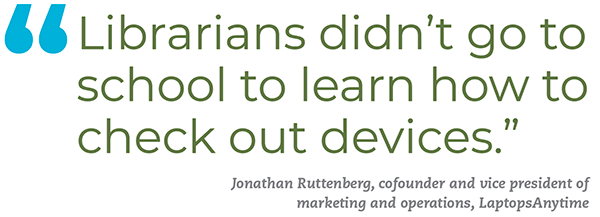 .
.
LaptopsAnytime offers a fully automated solution to this challenge. The company’s laptop dispensing kiosks help get mobile technology into the hands of community members who need it—without placing any additional burden on library staff.
The kiosks, which are available in 6-, 12-, 18-, 24-, and 30-bay units, can be fully customized to support laptops, Chromebooks, and/or tablets from a wide variety of manufacturers. (A library is responsible for buying its own devices.)
To access a device from the kiosk, users simply scan or swipe their library or university ID card. The machine can be programmed to fit a library’s local lending policies, and automatic notifications help libraries manage the laptop lending program. For instance, a designated administrator can receive a message if a device hasn’t been returned on time, a kiosk bay fails, or a user reports that a device needs servicing.
When a device is returned to an empty bay in the locked position, it’s docked to a power source for automatic recharging. Libraries can also choose to lic ense Deep Freeze or a similar program for restoring the device to its preset state.
ense Deep Freeze or a similar program for restoring the device to its preset state.
The net result? Users can sit and work where they are comfortable, and librarians are freed up to serve patrons more effectively.
LaptopsAnytime also sells a portable charger that enables library patrons to recharge the laptops, cell phones, and other mobile devices they bring from home. The charger comes with a built-in, 110-volt outlet and contains enough power to bring any mobile device to a fully recharged state. LaptopsAnytime kiosks can be configured to distribute the mobile chargers as well as laptops.
With the addition of this mobile power source, users do not have to sit near an electrical outlet. Patrons won’t be tripping on power cords plugged into walls. And libraries can ensure that patrons have enough power to do their work, without having to spend hundreds of thousands of dollars retrofitting their buildings.
Libraries pay a base fee to purchase LaptopsAnytime kiosks. An additional service and maintenance contract allows libraries to reconfigure the bays every three, four, or five years to coincide with their device update cycle.
LaptopsAnytime has sold its kiosks on every continent except Antarctica. The machines manage more than four million device checkouts per year. “It’s as secure as doing a manual checkout,” Ruttenberg says, “except it’s fully automated.”
Luna Imaging
The pandemic has proven the value of digital access to library collections. Libraries that have digitized their collections of photographs, documents, and other artifacts were able to provide online access to patrons when they shut down amid the threat of COVID-19.
Headquartered in Los Angeles, Luna Imaging helps libraries, museums, and other cultural heritage organizations manage and display their digitized collections. The company’s LUNA software is a cloud-based digital asset management solution designed to preserve images, videos, audio files, PDFs, and digitized books and manuscripts, making them available to the public online.
“Our software opens the door for libraries to expand their reach,” says Nancy Harm, director of business development.

Luna Imaging was started in 1993 by Dr. Michael Ester, drawing on his many years of experience working with cultural heritage materials as the director of the Getty Art History Information Program. Created with support from the J. Paul Getty Trust and Eastman Kodak Company, the company was an early pioneer in the digital imaging field—so it’s not surprising that its LUNA software is a visually powerful platform that includes tools for helping researchers zoom in on and appreciate fine details in digital images.
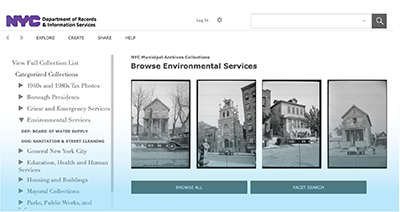 Users can also browse and search online collections, compare multiple items side by side, flip through digitized books page by page, save materials to user-created media groups, create dynamic slideshow presentations from digital assets, add annotations to saved assets, and more.Based on open-source software, LUNA is designed to make it simple for libraries to create their own digital collections. Librarians can add, edit, upload, and export media in bulk, and they can easily copy items between collections. They can add metadata for each asset, choosing which data fields can be sorted, searched, and displayed. They can control who has access to which materials, making some assets available to the general public while reserving access to other items for registered members as desired. Integrated analytics give librarians key insights into how their materials are being used.
Users can also browse and search online collections, compare multiple items side by side, flip through digitized books page by page, save materials to user-created media groups, create dynamic slideshow presentations from digital assets, add annotations to saved assets, and more.Based on open-source software, LUNA is designed to make it simple for libraries to create their own digital collections. Librarians can add, edit, upload, and export media in bulk, and they can easily copy items between collections. They can add metadata for each asset, choosing which data fields can be sorted, searched, and displayed. They can control who has access to which materials, making some assets available to the general public while reserving access to other items for registered members as desired. Integrated analytics give librarians key insights into how their materials are being used.
Collections published in LUNA are automatically optimized for search using Google and other search engines, and the software integrates with Summon, WorldCat, and other leading discovery services to make content easy to find in database searches as well. What’s more, Luna Imaging has created a global collection of content uploaded to LUNA, called the LUNA Commons. This site showcases public collections from a wide variety of sources; it’s another way participating libraries can display their digital assets and can be accessed via www.lunaimaging.com/luna-commons.
Libraries using LUNA include the John Carter Brown Library at Brown University, the Folger Shakespeare Library in Washington, DC, and the New York City Municipal Archive.
LUNA is available through a Software-as-a-Service (SaaS) subscription model, with flexible and scalable pricing based on a library’s needs.
FE Technologies
“The more efficient we can make the library, the more we can free up librarians to serve their communities more effectively,” says Scotty Gage, vice president of U.S. sales for FE Technologies.
Gage’s company sells solutions that enable libraries to use radio frequency identification (RFID) technology to check items in and out and keep track of their materials. Using RFID technology is much more efficient than using electromagnetic bar codes, he says, because multiple RFID tags can be read at the same time without requiring a direct line of sight between the tags and the scanner.
 Instead of having to scan the bar code on each individual item manually, a librarian can simply place four to six items on an RFID-enabled pad to check them out simultaneously. The time saved from not having to do administrative tasks manually frees librarians to focus on more strategic initiatives that can bring greater value to their patrons.
Instead of having to scan the bar code on each individual item manually, a librarian can simply place four to six items on an RFID-enabled pad to check them out simultaneously. The time saved from not having to do administrative tasks manually frees librarians to focus on more strategic initiatives that can bring greater value to their patrons.
FE Technologies, an Australian company that opened a U.S. office in Texas in 2019, sells RFID-enabled circulation stations, sorters, security gates, self-checkout systems, and check-in tools. For instance, the Smart Bin is a return unit with an RFID scanner that automatically checks in materials as they’re dropped into the bin. The company also helps libraries tag and encode their materials for recognition by an RFID scanner.
FE’s newest innovations give patrons secure, 24-7 access to books, videos, and other physical items—while expanding the reach of libraries within their communities.
The Display Reservation Locker allows reservations to be collected at a remote location anytime. Patrons can reserve an item online, then pick it up at their convenience. Each locker bay has its own electronic lock that’s opened when the patron scans his or her library card. A separate return bin is integrated into the unit’s design. The lockers are modular, which each unit offering 96 bays—including a few bays for oversize items.
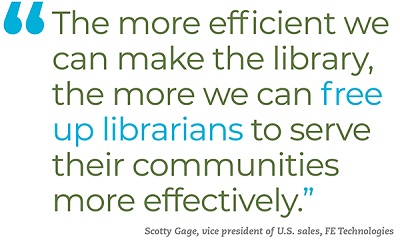 The Anytime Library is a standalone dispensing kiosk that enables patrons to borrow items anytime. It can hold more than 300 items and uses a unique carousel system to facilitate browsing. An intuitive, easy-to-use touchscreen interface guides users through the borrowing process. Patrons can search for items by title, author, or genre. The kiosk also contains an automated check-in system, so items go right back into circulation when they’re returned.
The Anytime Library is a standalone dispensing kiosk that enables patrons to borrow items anytime. It can hold more than 300 items and uses a unique carousel system to facilitate browsing. An intuitive, easy-to-use touchscreen interface guides users through the borrowing process. Patrons can search for items by title, author, or genre. The kiosk also contains an automated check-in system, so items go right back into circulation when they’re returned.
These two products, which can be strategically located in recreational centers, convenience stores, and other public spaces, not only help libraries extend their services into underserved areas of the community; they also provide options for patrons who can’t access the library for one reason or another.
A mobile app from FE Technologies, called the Librarian Rover, is changing how library staff serve their patrons by untethering them from the circulation desk. The app allows library staff to check out items, accept returns, and create or update patron records from the palm of their hand. This empowers staff to interact with patrons in the stacks, answering questions and providing the same level of service that retail employees routinely deliver.
“We’re excited about helping libraries engage with their communities in ways they couldn’t before,” Gage says.
Kodet Architectural Group LTD
Every aspect of a library’s design plays a key role in making the space highly functional—from the outdoor space to the placement of meeting rooms to the acoustic design—so that librarians can engage their communities in new and creative ways. Based in Minneapolis, Kodet Architectural Group has been designing school and public libraries that support innovative programs and services for more than 20 years.
A prime example is Pleasant Hill Library in Dakota County, MN, which hired Kodet to update its facility to serve the public more effectively. “The original space had numerous functional issues,” says senior project manager Teri Nagel.
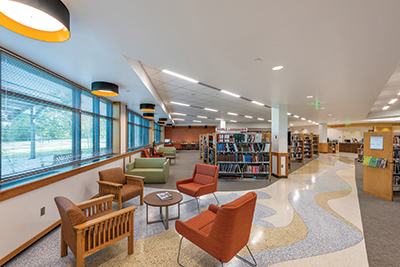 For instance, there was no designated area for teens, and meeting space was in short supply. The children’s area overlapped with the main part of the library, and many adults said they had a hard time concentrating with all the noise the children made. Library officials also wanted to add a makerspace for 3-D printers, sewing classes, and other hands-on learning and craft opportunities for patrons.
For instance, there was no designated area for teens, and meeting space was in short supply. The children’s area overlapped with the main part of the library, and many adults said they had a hard time concentrating with all the noise the children made. Library officials also wanted to add a makerspace for 3-D printers, sewing classes, and other hands-on learning and craft opportunities for patrons.
Kodet reshuffled the floor plan to create more clearly delineated areas while preserving an open-concept space. The firm also worked with an acoustic engineer to install sound-absorbing acoustic tiles in the ceiling and lowered the height of the shelves to create better sight lines throughout the facility. The use of lighter, natural wood tones helped make the space feel warmer and more inviting.
By adding 1,500 square feet to the design, Kodet was able to create private meeting rooms that will bring in new community members, as well as a modern makerspace set apart from the main library by glass walls.
“The redesign has created new opportunities for Pleasant Hill to engage with the public,” Nagel says. “That has been a really positive impact for both the library and the community.”

Project designers incorporated multiple seating options for patrons, including high-top tables and comfy chairs. They also involved the community in the design of the facility, by asking for opinions on what furniture should be used. “We wanted the public to have a say in the process,” Nagel observes.
At the request of library officials, the designers created a shaded, trellis-covered outdoor learning area as well. This space has proven to be very useful for hosting outdoor events during the pandemic.
There are also several design touches that help make the space unique to the community. For example, a map of the area and its main geographic features is painted on the floor, and the library’s meeting rooms are named after buildings in the community.
The redesign has resulted in a more flexible and adaptable space that enables Pleasant Hill to meet emerging needs more effectively.
“When we began the design work, the main goal from the start was an accessible, welcoming, and flexible space that meets the community’s needs,” says Margaret Stone, director of Dakota County Library. “The finished design exceeded our expectations, and it’s working very well. The community loves using the variety of spaces for collaboration, for talking, for learning while playing, and for study and work.”
Tappé Architects
For Jeffrey Hoover, director of library design for Boston-based Tappé Architects, the central question when designing a public facility is: “How can you get a community building to build community?”
A library is the center of civic discourse and opportunity within its community, he says. However, the design of the facility can either support or hinder community engagement. To design buildings that promote engagement, architects must understand the current needs of the community while anticipating future needs as well. This process begins by learning as much as possible about the community’s identity and its key aspirations.
That’s exactly what Tappé did when it designed a new building for Tufts Library in Weymouth, MA, replacing the existing facility from the 1960s with a modern, 52,000-square-foot building.
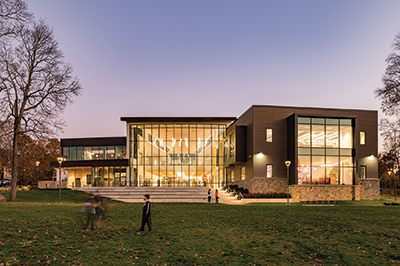 By getting to know the community, Hoover and his colleagues learned that the facility “needed to become the new town center and the hub of civic identity,” he says. The new Tufts Library had to be a place where the community could gather to learn additional skills and not just consume information but also co-create it.
By getting to know the community, Hoover and his colleagues learned that the facility “needed to become the new town center and the hub of civic identity,” he says. The new Tufts Library had to be a place where the community could gather to learn additional skills and not just consume information but also co-create it.
The design process began in March 2018, and the new facility opened in September 2020. A two-story common area—traditionally the center of town in old Massachusetts cities—is situated in the middle of the building and serves as an open gathering space. Nine group study rooms of various sizes are located around the commons.
The new building contains a digital media lab and makerspaces for both teens and adults. “These spaces are designed to keep that hands-on learning spirit alive, even as patrons get older,” Hoover says.
Book collections are displayed on A-frame shelving that creates open sight lines. Motion-sensitive lights above these stacks turn on automatically when someone approaches, which saves on energy.
There are many different seating options throughout the building, including café-style tables, reading areas with built-in power outlets integrated into the tabletops, and even study carrels built into the book stacks for private embedded workspaces. “We want everyone to find their ‘right’ seat in the library,” Hoover says. “Where you feel comfortable reading or working depends on a lot more than just the hardness of the seat.”
The new library looks out onto a grassy park in the back. A new butterfly garden and amphitheater create space for outdoor activities.
By listening closely to the community’s needs, Tappé has created a facility that will support a wide variety of activities and serve a broad range of roles—including small business information center, innovation incubator, early learning center, and even teen hangout spot.
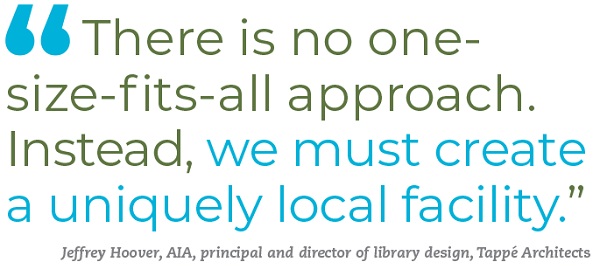
“In order to get libraries right in the 21st century, we need to steer away from global solutions,” Hoover says. “There is no one-size-fits-all approach. Instead, we must understand what local communities want and create a uniquely local facility.
Library Ideas
Established in 2008, Library Ideas® develops products to help libraries reach patrons in new ways. The company has more than 5,000 library customers in more than 20 countries.
Library Ideas’ first product was Freegal® Music, a cloud-based music service that is like Spotify for libraries. For a single subscription fee, libraries can give their patrons unlimited access to streaming and downloading from more than 40,000 music labels worldwide.
“Music CDs are a staple in library collections,” says founder and CEO Brian Downing. “But as technology has changed, no library can meet its patrons’ needs with just CDs. And free music streaming services are akin to radio: they’re ad-supported services that don’t allow you to create playlists.”
In contrast, Freegal allows users to download songs to their device and create customized playlists. Libraries can also create community-based playlists for sharing with their members. For instance, the District of Columbia Public Library has created a playlist of go-go music for patrons to enjoy and learn about this genre that originated in DC.
Library Ideas’ other products include Rocket Languages, an online system that allows patrons to learn new languages at their own pace, and Freading®, the first pay-per-circulation ebook collection for libraries. With Freading, libraries have access to more than 200,000 ebook titles with no up-front cost: instead, they pay a nominal fee when each title is used by patrons. It’s a good model for libraries to give their patrons access to infrequently read titles at a low cost.
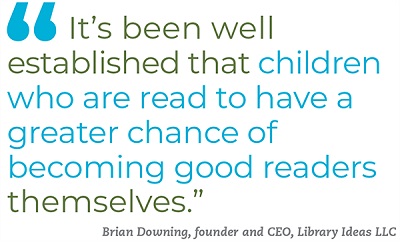 Recently, Library Ideas started its own publishing company, VOX TM Publishing. The company’s signature products are VOX Books, or “books that talk.” These printed books provide full audio narration at the push of a button so that children ages 3–9 can listen as they read along in the text, using an audio reader attached to the book’s inside cover.
Recently, Library Ideas started its own publishing company, VOX TM Publishing. The company’s signature products are VOX Books, or “books that talk.” These printed books provide full audio narration at the push of a button so that children ages 3–9 can listen as they read along in the text, using an audio reader attached to the book’s inside cover.
In addition to publishing 72 English-language titles per year, VOX publishes bilingual titles in Spanish and Mandarin Chinese, with Tagalog, Arabic, Russian, Korean, French, and German versions coming soon. Additionally, the new iVOX app brings the read-along experience completely online for families.
Besides VOX Books, VOX Publishing also produces IR BooksTM, which provide an immersive reality experience for children ages 5–12. These books focus on science-related subjects, such as the moon or industrial robots. At different points in the book, readers can scan a QR code with a mobile phone to launch a 360-degree immersive experience. “Children can read about the moon and then go to the moon,” Downing says. Priced at $38, each book includes a plastic-coated set of immersive reality goggles.
Library Ideas’ latest product is a fully moderated online book club for libraries. The service includes unlimited simultaneous access to five electronic titles per year, and patrons can vote on the books they want to read from a preselected list. Over the course of eight weeks, patrons can dissect each book through asynchronous online discussions led by an expert on the book in question. There is no limit to the number of participants.
“It’s a complete, turnkey solution to help libraries engage with their communities more effectively,” Downing says.
Preparing for post-pandemic success
Libraries are emerging from the pandemic stronger, more resilient, and more indispensable to their communities than ever before. Now, they must continue to demonstrate additional value to patrons. With the right tools and resources, librarians will be well prepared to face both new and ongoing challenges.
“In order to succeed, libraries will have to continue serving patrons in places and in ways they weren’t able to before,” Gage says.
SPONSORED CONTENT
Love this article. I know of a country that is in need of this type of technology and solutions for their youth and citizens.
Add Comment :-
RELATED
ALREADY A SUBSCRIBER? LOG IN
We are currently offering this content for free. Sign up now to activate your personal profile, where you can save articles for future viewing









